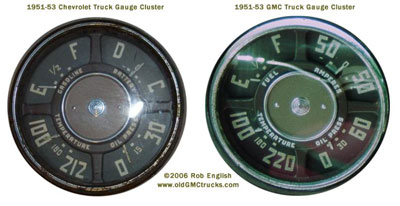
On first glance, most people assume that both Chevy and GMC gauge clusters are fully interchangeable and are the same except for perhaps the minor difference with Chevy oil gauges topping out at 30 psi versus GMC gauges maxing out at 60 psi. But that's quite a bit short of what the actual differences were originally! There are actually no less than five distinct differences in the same year gauge clusters when taken from same size trucks. Below you will see two examples of late 1951 to 1953 gauge clusters; one on the left from a Chevy truck, and the one on the right from a GMC truck. Before you start jumping up and down about the tan background brown letter gauges in 1951, realize that the gauge clusters changed in late 1951 and then stayed brown background cream letters up through 1953. The first and most obvious difference is the oil gauge, but upon closer inspection you'll find twelve distinct differences between them; six on each gauge cluster.
- GMC oil gauge reads 60 psi while the Chevy oil gauge tops out at 30 psi
- GMC used an Ampere gauge showing 50- | +50 where Chevy used a C | D Charge/Discharge style gauge
- The label under the electrical gauge on Chevy clusters says simply "BATTERY" while on the GMC it says "AMPERES"
- GMC temperature gauges maxed out at 220F where Chevy temperature gauges stop at 212F until 1953. In 1953 Chevrolet matched GMC with 220F
- The GMC fuel gauge was used for both big and small trucks, so it reads "FUEL" where the Chevy gauge reads "GASOLINE" since there were no Chevy diesel trucks at that time
- The Chevy gauges all have longer 2/3rds way needles than the GMC gauges with half-way needles
So the next time you're shopping for gauges, these subtle differences may help you to better understand what you need whether you are driving a Chevy or a GMC.
Rob English


